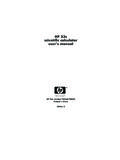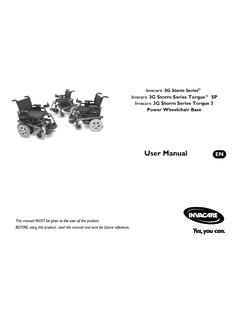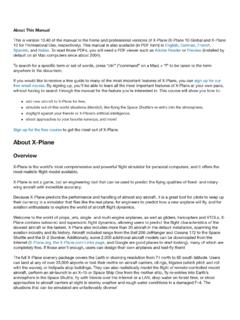Transcription of LP612 and LP624 User's Manual - Leprecon, LLC
1 RLP612 and LP624 User's ManualRev. Software Version Software Version , Box 430, 10087 Industrial Drive, Hamburg, MI 48139-0430 810-231-9373, FAX 810-231-1631 Copyright CAE, Inc. January 1997, Publication # 21-2125D1EZ PROGRAMMING THE LP-600 SERIESP rogramming Preset Press the "Preset" menu to light the "Page" LED2. Select desired page (1-4) using display "Up" or "Down" arrows3. Press "Record" button4. Set desired look by arranging X scene channel faders5. Store by pressing bump button beneath desired preset fader on Y scene, continue setting and "Run" to play scenes backProgramming a Press "Chase" button to light "Pattern" LED2. Select desired pattern (5-11) on display using "Up" arrow3. Press "Chase" menu button again to light "Step" LED4. Press "Record" button5.
2 Set desired look on X scene faders6. Press the display "Up" key to record & advance to next step, continue to set and record chases7. Press "Run" key to end programmingTo Record Stack Press the "Stack" menu button to display now scene. Use the "Down" key to set now to (CL may momentarily appear).2. Press the "Stack" menu key again to light the "next" Use the display up and down keys to select a cue number of 1 through Set levels on stage using Manual channels or Press the "Record" key once. The "Record" LED will begin to Press "Record" again to memorize the cue. The next cue number will In record mode, continue setting desired levels on stage and recording cues (stacking). "Run" to end recording and activate "Cue Stack". in "next" mode use display Up and Down keys to call upfirst cue for "Stack" fader to manually crossfade between cues or use GO button to time fade to next PIN ASSIGNMENTS : LP612 PIN ASSIGNMENTS : LP624 AND Y PRESET IN Manual DIMMERS.
3 13 USING MEMORY MENU: LP612 MENU: LP624 PRESETS INTO STACK FADE FADE NEW CHASES: LP624 AND WARRANTY LP612 and LP624 were designed with the goal of creating low-cost, high quality controlconsoles. The LP600 series boards share many features with the larger Leprecon LP1500consoles, but brings these features within reach of users with a smaller budget. Some of thesefeatures are: Manual scenesTwo scene Manual presets. Switchable Add or Solo momentary buttons for each channel. Diplesscrossfade between Manual scenes. Each channel has a large, easily visible LED MemoriesReal-time preset faders with switchable Add or Solo bumps. Presets may be "piled on" in anycombination. Presets are assigned to one of four memory pages. Preview mode allows cues to bechecked without bringing up the scene on stage.
4 An existing cue may easily be edited using themanual scene faders without re-recording the entire Stack50 programmable cues with crossfader and go button control. Fade times can be assigned toeach scene. A two character display is used to indicate current and next cues, and programmedfade fixed and seven programmable patterns of up to twenty-four steps each are patterns are recorded, previewed and edited as easily as the preset cues. The rateof each pattern may be saved with the Chase, eliminating the need to adjust the rate pot when theChase is recalled. The Chase may be advanced a step at a time manually, or halted output is industry standard Microplex using a three pin XLR connector. The optionalDMX 512 output uses the standard 5 pin XLR as specified by USITT, and the analog option usesCinch-Jones connectors common on other Leprecon output protocols can be used DesignationsThe LP600 series consists of two consoles; the LP612 and the LP624 .
5 As the controls of bothconsoles are very similar, the designation LP600 is used to describe common features. Thesections of this Manual specific to either board are marked as LP612 Only or LP624 Only .4 SetupThe LP600 connects easily to most types of dimming systems. Microplex, as well as the optionalanalog and DMX 512 outputs are provided for dimmer control. The flexibility to interface to varioussystems makes the LP600 a natural choice for building a new system, or upgrading an requirementsThe LP600 console can be powered in two ) With Microplex dimmers, the microphone cable between the dimmer and controller suppliesboard power. No external supply connection is ) With DMX and analog options, an external supply must be used to power the board. Thistransformer is supplied as part of the option package.
6 This transformer is rated for 12 VAC at the board is to be used with European power systems, or other 230 volt applications, contactyour Leprecon dealer for the correct 230 volt power OutputThe three pin XLR connectors at the back of the LP600 are used to connect the board to standardMicroplex dimmers. This connection will work with Leprecon 360 Microplex dimmers, and hasbeen tested with other products for is suitable for use in smaller systems, up to 64 channels. Ordinary microphone cablemay be used to connect the LP600 to Microplex OutputThe DMX 512 digital output on the rear panel offers a fast and reliable way of sending controlinformation to the stage. Simply connect a 5-wire DMX control cable from the console output tothe DMX input on the dimmer. As the standard mandates, the LP600 has a 5 pin XLR femaleconnector.
7 Additional dimmers can be "daisy-chained" from the first dimmer, by running additionalcables between the uses a high speed digital signal, and the correct cable type is essential for reliableoperation. Microphone cable is not DMX cable. Use of microphone cable for DMX 512 is LP600 has been tested and complies fully with the USITT DMX 512/1990 standard, andshould pose no compatibility problems with any DMX 512 dimmers from Leprecon or from othermanufacturers. Should any suspected incompatibilities be encountered, please contact yourLeprecon dealer with the specific dimmer model and OutputEven with the advent of digital control standards, many portable lighting systems use analogcontrol lines between the console and the dimmer racks. The LP600 provides 0-10 volt analogoutputs, using Cinch-Jones connectors.
8 The pin connection of these connectors is identical to thatused on many other Leprecon Pin Assignments : LP612 ONLYThe analog version of the LP612 uses two panel mount male Cinch-Jones 8 pin connectors forcontrol output. The pin connections are as follows:121818 Connector 1 PinFunction1 Channel 12 Channel 23 Channel 34 Channel 45 Channel 56 Channel 67No connect8 CommonConnector 2 PinFunction1 Channel 72 Channel 83 Channel 94 Channel 105 Channel 116 Channel 127No connect8 Common6 Connector Pin Assignments : LP624 ONLYThe analog version of the LP624 uses one panel mount male Cinch-Jones 27 pin connector forcontrol output. The pin connections are as follows:127 PinFunction1-24 Channel 1-2425No connection26,27 Common7 Control LayoutThe diagram below illustrates some of the controls that will be referenced in this the LP612 is shown, the controls of the LP624 are Indicators1nownexttimegomasterstackmanua lcrossfadestepratepatternchasepreviewbum ppresettaprecordmodeonononpagestackchase run23456789101112 xy123456789101112 Menu Buttons Chase Stack PresetLED DisplayX Scene FadersY Scene FadersDisplayUp & DownGo ButtonD108642010864201086420108642010864 2010864201086420108642002468101086420108 64201086420108642010864201086420xyManual CrossfaderBump ButtonsTap Button612 Master8 StartupThe console will perform a brief test when power is applied.
9 If the board fails power-on testing, thedisplay will show:Any error message indicates problems that must be repaired. Some errors may leave the LP600functional in Manual mode ModeThe LP600, in addition to being a powerful memory console, can also be used as a simple two-scene preset board. This allows an untrained operator to immediately start using the board, andlearn it's more advanced features as time set the LP600 to Manual mode, press the 'preset' menu button. The 'page' LED will the 'down' arrow until the display shows:nownexttimestackstepratepatterncha sepreviewbumppresetrecordmodeonononpager un612 This indicates that the preset memories are off. The 'preset on' LED will be turned and Y Preset ScenesThe most basic control of the LP600 console is provided by the rows of faders for the two manualscenes, labeled "X" and "Y.
10 " Each X and Y pair of faders controls a single console channel, whichmay be connected to one or more dimmer channels. The green output LED above each channelindicates the channel's relative Manual Crossfader, just to the left of the Y scene faders, is used to fade from the top Manual (X) scene to the lower(Y) Manual scene. With the fader at the top position, the board output willbe set by the levels on the X scene faders. If the crossfader is moved to the bottom position, thelevels on stage will be set by the position of the Y scene , a scene might be set up with the X channel faders in advance, and when that cue iscalled, the Manual crossfader is moved upward together to the X position. This leaves the Yscene available to be set up for the next cue. At the appropriate time, the Crossfader is pulleddown to the Y position, and the now inactive X scene available to be set for the next Master fader is used to set an overall output level for most board controls.







